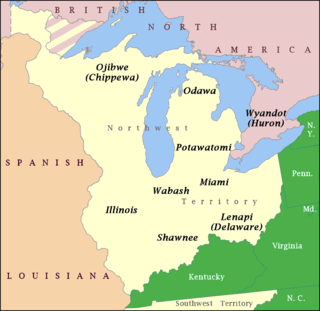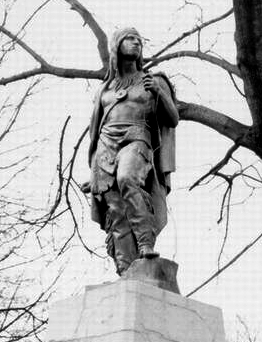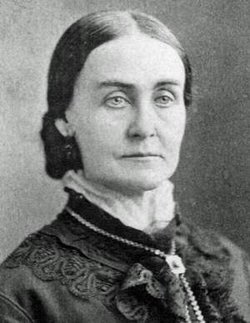
Richland County is a county located in the U.S. state of Ohio. As of the 2020 census, the population was 124,936. Its county seat is Mansfield. The county was created in 1808 and later organized in 1813. It is named for the fertile soil found there. Richland County is included in the Mansfield, OH Metropolitan Statistical Area as well as the Mansfield-Ashland-Bucyrus, OH Combined Statistical Area. The county is one of the six Metropolitan Statistical Areas that make up Northeast Ohio.

Lucas is a village in southeastern Richland County, Ohio, United States. Lucas is part of the Mansfield, Ohio Metropolitan Statistical Area. The population was 589 at the 2020 census.

Mansfield is a city in and the county seat of Richland County, Ohio, United States. The population was 47,534 at the 2020 census. Located approximately 65 miles (105 km) from Cleveland and Columbus via Interstate 71, it is part of Northeast Ohio region in the western foothills of the Allegheny Plateau.

Johnny Appleseed was an American pioneer nurseryman who introduced trees grown with apple seeds to large parts of Pennsylvania, Ohio, Indiana, Illinois, and Ontario, as well as the northern counties of West Virginia. He became an American legend while still alive, due to his kind, generous ways, his leadership in conservation, and the symbolic importance that he attributed to apples. He was also a missionary for The New Church and the inspiration for many museums and historical sites such as the Johnny Appleseed Museum in Urbana, Ohio.

The Lenape, also called the Lenni Lenape and Delaware people, are an Indigenous people of the Northeastern Woodlands, who live in the United States and Canada.
John Gibson was a veteran of the French and Indian War, Lord Dunmore's War, the American Revolutionary War, Tecumseh's War, and the War of 1812. A delegate to the first Pennsylvania constitutional convention in 1790, and a merchant, he earned a reputation as a frontier leader and had good relations with many Native American in the region. At age sixty he was appointed the Secretary of the Indiana Territory where he was responsible for organising the territorial government. He served twice as acting governor of the territory, including a one-year period during the War of 1812 in which he mobilized and led the territorial militia to relieve besieged Fort Harrison.

The Gnadenhutten massacre, also known as the Moravian massacre, was the killing of 96 pacifist Moravian Christian Indians by U.S. militiamen from Pennsylvania, under the command of David Williamson, on March 8, 1782, at the Moravian missionary village of Gnadenhutten, Ohio Country, during the American Revolutionary War.
The Zimmer massacre was the massacre of four settlers by Native Americans in Mifflin Township, Ashland County, Ohio in September, 1812. Although the exact motive for the attack is unknown, the end result was that four settlers were killed, further increasing the distrust between Native Americans and settlers at the beginning of the War of 1812.

Charles Mill is a reservoir located in central Ohio near the junction of State Routes 430 and 603. Charles Mill Lake is a quiet and enjoyable place for boating, camping, fishing, hunting, or hiking. The lake is located in both Richland County and Ashland County, with the dam located in Ashland County. This lake is located on the Black Fork of the Mohican River. Many local residents refer to Chales Mill Lake as Mifflin Lake due to its proximity to Mifflin, Ohio. The lake primarily sees local use by nearby residents who fish or boat; the marina is accessible from St. Rt. 430.

The Christian Munsee are a group of Lenape, an Indigenous people in the United States, that primarily speak Munsee and have converted to Christianity, following the teachings of Moravian missionaries. The Christian Munsee are also known as the Moravian Munsee or the Moravian Indians, the Moravian Christian Indians or, in context, simply the Christian Indians. As the Moravian Church transferred some of their missions to other Christian denominations, such as the Methodists, Christian Munsee today belong to the Moravian Church, Methodist Church, United Church of Canada, among other Christian denominations.

Newville was a town located near what is now Pleasant Hill Lake, in northeastern Worthington Township, Richland County, Ohio, United States.

The Big Bottom massacre was a mass killing perpetrated by Lenape and Wyandot warriors against American settlers on January 2, 1791. The massacre occurred near present-day Stockport, Ohio. It is considered part of the Northwest Indian Wars, in which native Americans in the Ohio Country clashed with American settlers, seeking to expel them from their territory.

The Crawford expedition, also known as the Battle of Sandusky, the Sandusky expedition and Crawford's Defeat, was a 1782 campaign on the western front of the American Revolutionary War, and one of the final operations of the conflict. The campaign was led by Colonel William Crawford, a former officer in the U.S. Continental Army. Crawford's goal was to destroy enemy Native American towns along the Sandusky River in the Ohio Country, with the hope of ending Native attacks on American settlers. The expedition was one in a series of raids against enemy settlements that both sides had conducted throughout the war.

The Northwestern Confederacy, or Northwestern Indian Confederacy, was a loose confederacy of Native Americans in the Great Lakes region of the United States created after the American Revolutionary War. Formally, the confederacy referred to itself as the United Indian Nations, at their Confederate Council. It was known infrequently as the Miami Confederacy since many contemporaneous federal officials overestimated the influence and numerical strength of the Miami tribes based on the size of their principal city, Kekionga.

Captain Pipe (Lenape), called Konieschquanoheel and also known as Hopocan in Lenape, was an 18th-century Head Peace chief of the Algonquian-speaking Lenape (Delaware) and War Chief 1778+. He succeeded his maternal uncle Custaloga as chief by 1773. Likely born in present-day Pennsylvania, he later migrated with his people into eastern Ohio.
David Williamson (1752–1814) was a mass murderer and colonel in the Pennsylvania Militia during the American Revolutionary War. He was born near Carlisle, Pennsylvania, and led American militiamen in the Gnadenhutten massacre of the Moravian Christian Indian Martyrs, though he failed in his plan to massacre the Christian Indians in Schoenbrunn. He led Pennsylvanian soldiers in the massacre of peaceful Delaware Indians in Killbuck Island and was second in command in the Crawford expedition.
Hell Town is the name for a Lenape Native-American village located on Clear Creek near the abandoned town of Newville, in the U.S. state of Ohio. The site is on a high hill just north of the junction of Clear Creek and the Black Fork of the Mohican River.
Lenape settlements are villages and other sites founded by Lenape people, a Native American tribe from the Northeastern Woodlands. Many of these sites are located in Ohio and Pennsylvania.

Rosella Rice was an American author, poet, and lecturer born in Perrysville, Ohio. She was known for her direct and energetic comedy writing, her nature poems, and her vivid descriptions of folklore figure John "Johnny Appleseed" Chapman.














